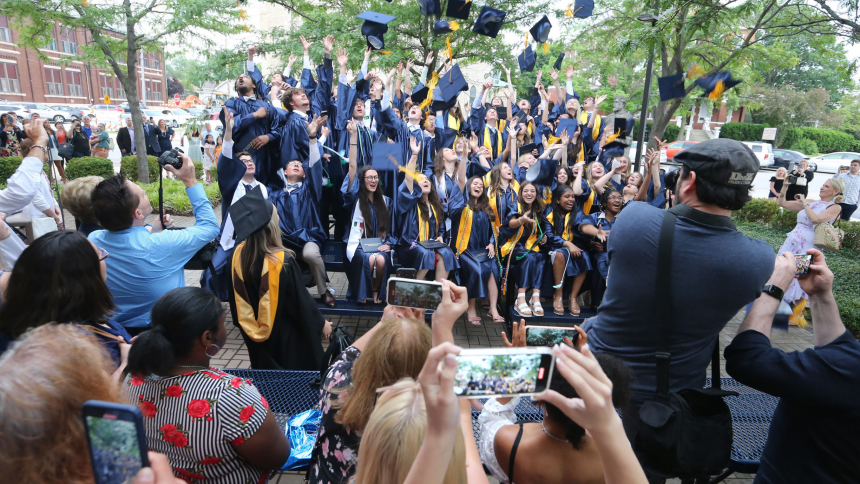
Mission Statement
Our Catholic Schools in the Diocese of Gary form our children to be fully alive as disciples of our Lord Jesus Christ in their intellects, hearts and souls. The clarity of this purpose finds full expression in a robust Catholic identity, a stimulating academic excellence, committed operational vitality and effective governance and leadership.
Vision Statement
We teach and learn, pray and serve, love and give as disciples of Jesus Christ.
Goals for Teaching and Learning
- Academic Excellence
-
Objective: Develop a unified process to collect, monitor, analyze and evaluate student growth and achievement data to inform instructional practices and enhance student support.
Indicators of Success
- A calendar for curriculum development, evaluation, and revision
- Ongoing curriculum revisions across grade levels and content areas
- System-wide, high quality, and consistent professional development
- Increases in student growth and achievement metrics
- Innovation
-
Objective: Identify and organize professional development in research-based best practices for embedding instructional and assessment strategies in the 1:1 classroom
Indicators of Success
- Ongoing professional development related to technology best practices for teaching and learning
- Each school has a technology plan that identifies goals and strategies to maintain and upgrade technology, 1:1 device, and systems of operation
- Retention & Recruitment
-
Objective: The Office of Catholic Schools should continue to develop a new teacher orientation program, prioritizing intentional onboarding and continued support for all new teachers in the diocese
Indicators of Success
- New teachers feel effective and supported
- New principals feel effective and supported
- Faith Formation & Catholic Identity - Intersect all Goals
-
- The Diocese of Gary is committed to strengthening its Catholic identity and prioritizing the faith formation of all students, faculty, and staff. Teachers are supported through catechetical courses, and students PK-12th grade are catechized in the rich traditions of the Catholic faith
- Students in the Diocese of Gary are provided daily opportunities to see faith in action and to live out the Synod 2022's ten principles for being missionary disciples. Through daily prayer, religion classes, weekly Masses, the sacraments, and service, students are learning to become missionary disciples
Meeting the needs of all learners
- What is offered?
-
Programs are available at all levels to accommodate the needs and interests of our most advanced learners, those who need extra support to be successful, and all learners in between. Robust curricula, knowledgeable and effective teachers, a positive learning environment, and a culture of continuous improvement equip students to meet the challenges of living in an ever-changing world.
- Equitable access
-
All students, including those with IEPs, in our school have equal access to the general education curriculum and extracurricular learning activities with appropriate supports.
- Supportive & inclusive district culture
-
All faculty and staff are expected to support all students, regardless of their title or student need, instruction and supports are respectful, and can be flexible and innovative, meeting the diverse needs of students.
- Culturally responsive practices
-
All school personnel (i.e., instructional, and other personnel) share responsibility and employ culturally responsive practices to educate all students in our school. Culture is central to learning. Learning environments and activities that reflect students’ social, cultural, and linguistic experiences maximizes learning opportunities and makes instruction relevant for students.
A strong Catholic education means:
- Collegiate preparation – 94 percent of Catholic school graduates attend a college or university
- Faith-based – The goal of Catholic education is to help children understand and explore their faith. Religious formation begins at home and carries on to the classroom.
- A strong community – students and families dedicate hundreds of millions of volunteer service time to their schools. This is vital and critical to the continued growth of Catholic education.
- Student-focused faculty and staff – Catholic schools teachers provide a rigorous curriculum that challenges students to achieve academic excellence in and out of the classroom.
Facts about Catholic Schools
- Ninety nine percent of Catholic students graduate high school. Of those graduates, 86 percent will attend a four-year college or university.
- Forty five percent of the Catholic schools in the U.S. participate in federal nutrition programs, which provide over 270,000 free meals to children daily.
- Catholic school graduates have higher earning potential compared to public school graduates.
- Academic achievement is higher in Catholic schools.

